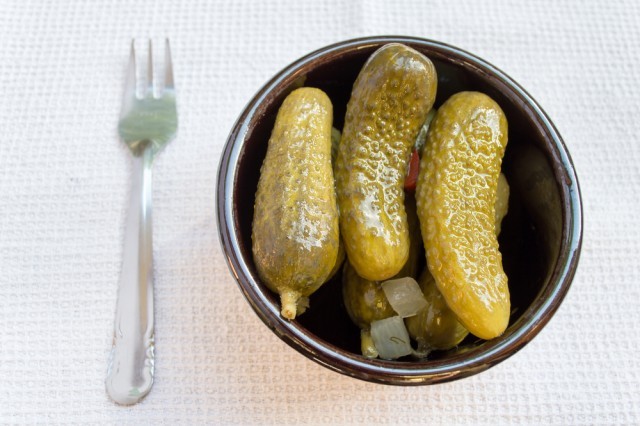I like craft cocktails, and I like small plates dining. One of my favorite places to experience both is at The Eddy in Providence, RI. Owner/Operator Jay Carr is mostly behind the Eddy bar, and he and his staff skillfully mix some of the best craft offerings in the region. Chef Jonathan Beres is mostly manning the kitchen, overseeing the production of items that are simple, interesting, and crowd-pleasing. It is one of the most sensible bar menus I have ever come across.
I recently spent an afternoon with Jay and Jonathan discussing their overall operations, focusing on food and the kitchen. Make no mistake: The Eddy is first and foremost a place to come to drink, with food offerings that support that primacy. The how-to steps below provide a virtual blueprint for successfully offering food in that kind of establishment. But even if your operation differs, if the bar is attached to a restaurant or if there’s a full kitchen serving a full menu, considering the advice and observations below can vastly improve the food part of any food and beverage operation.
A HOW-TO ON SMALL PLATES
The menu is the key
Every other consideration that follows on this list is directly connected to and informs the menu development. Regardless of the opportunities and limitations resulting from the circumstances of the operation, the menu needs to be creative and balanced, offering guests an attractive combination of ingredients, flavors, textures, temperatures. The Eddy menu does exactly this, adding interest by paying homage to traditional bar favorites and Rhode Island’s unique ethnic heritage and geographic location. Items are hot and cold and include Italian cuisine, meat, and seafood. Selections like chips, nuts, and pretzels are traditional bar snacks with a twist. Deviled eggs, pickles, and jerky are a re-imagining of the contents in jars at the end of a shot or at the counter of a beer dive bar. “It’s a bar,” said Carr, “and I wanted the menu to focus on that.”
Keep it consistent
The menu at the Eddy doesn’t change frequently. “We don’t cycle menus or change a large number of items at once. We don’t want to dump that much new staff on our staff,” said Carr. Grazing bar patrons want their “snacks” immediately. One of the key benefits of a small plates menu is the ability make and serve items quickly, meeting the needs of patrons and effectively increasing the volume of dishes a kitchen can produce. Wholesale changes can slow operations down, at least for a while, negatively affecting both benefits.
Change it up
There are an infinite number of small plates and it makes sense to periodically swap one out with an item that has disappointed. “We put a smoked bluefish on the menu and sold four in a month, so we dropped it,” said Beres. The addition of the cod cake has been a much bigger success. Items are regularly added to and removed from the Eddy menu, keeping staff creative and patrons engaged.
Price it right
The small plates at The Eddy are mostly priced between $5 and $10. They want to make ordering food attractive to their bar patrons. Jon Taffer, industry expert and host of Spike’s Bar Rescue, tells us that people who are eating will stay at a bar for about an hour longer than if they weren’t eating. Conservatively, they can be expected to have at least one more drink during that hour. You don’t have to lose money on the food, but you don’t really have to make any. One more cocktail sold, at an 80 percent margin, is really what makes selling food profitable.
Consider space and equipment
The kitchen at The Eddy is about 250 square feet and has less than $10,000 worth of equipment in it. The menu reflects this circumstance. The menu is pretty evenly split between items that require some preparation before service and others that are prepared à la minute during service, assuring that the limited equipment doesn’t get overwhelmed and slow production.
Consider staff and staffing
There are two members of The Eddy kitchen staff. “Only one of us works at a time,” said Beres. As with the space and equipment considerations mentioned above, the menu needs to reflect this circumstance, as well. And again, the make-up of the menu makes this one man show tenable. The items on the menu that can be prepared in advance of service can be thought of like batched cocktails. Work can be performed in advance of busier service times, taking some pressure off the kitchen and creating increased overall capacity. “When we make changes, I pretty much keep the ratio the same between items on the menu that we can prep in advance and those we can’t,” added Beres.
TAKEAWAYS
Owner Jay Carr’s decades of food & beverage experience are apparent, based on the success of his craft cocktail bar The Eddy. Under his direction, Chef Jonathan Beres has nearly doubled food sales by producing a limited small-plates menu that is creative, interesting, and exceptionally well executed. While beverages remain the focus of this operation, food enhances the patron experience and serves to increase beverage sales. Following this blueprint, bent to specific needs, can result in the same successes in a variety of operations.
This article originally appeared on Nightclub.com.
Ready to find out more about the BS – Culinary Arts & Food Service Management? Contact us at 855-JWU-1881 or [email protected]. You can also fill out the “Request Info” form on this page.
